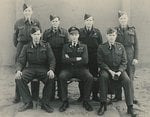BikerBabe
Senior Master Sergeant
The story in danish:
jp.dk - Murermester finder krigshistorie - Indland
Remains of a crashed bomber was discovered, when a chief bricklayer found a machine gun on Southern Funen, when he was digging.

The bomber broke into several pieces at the crash on Southern Funen in 1944.
Here, two german soldiers guards one of the engines, that has lodged itself in the ground.
Photo: RobertsMMs
It was a somewhat unusual discovery that a chief bricklayer made, when he was digging to prepare a foundation of a building on Southern Funen.
Suddenly, a three-barreled machine gun appeared, complete with ammunition.
The discovery was made at Øster Skerningevej in Vester Skerninge, and both ammunition and machine gun had seen better days. The three 80-90 cm's long barrels had been bent.
The weapon turned out to belong to a british aircraft, that were shot down over Southern Funen during WW2, according to the police at Funen.
Things went wrong over Southern Funen
During the evening on April 32rd, 1944, the Stirling bomber LJ526 from 149th Squadron at Lakenfield Airfield, Suffolk, England, took off.
The seven-man-aircrew from England, Canada and Australia were experienced and had been on many sorties, where they - among other things - had laid out mines in the Kieler bay.
So the task on April 23rd, where they were supposed to drop mines in Femern Bælt, was almost a routine mission for the crew.
But at night over Southern Funen things went wrong.
The crew got into air combat with a night fighter from the german Luftwaffe.
Two allied planes were shot down, and LJ526 crashed near the border between Øster Skerninge and Ollerup.
The day after, you could read in Svendborg Avis (Newspaper), how witnesses at 23:15 (11:15 PM DT) had seen a british plane "crash burning in Øster Skerninge, and how the plane fell apart in several pieces".
None of the seven crew members survived.
Examines weapon
66 years later, the machine gun from the downed aircraft turns up, when a chiefbricklayer were going to dig to prepare a foundation for a new building.
- we've taken the weapon into possession, and we'll try to find out if a museum or something like that has any interest in it, says Lars Fredensborg from the Funen Police.
---------------------------
Roughly translated by me.
jp.dk - Murermester finder krigshistorie - Indland
Remains of a crashed bomber was discovered, when a chief bricklayer found a machine gun on Southern Funen, when he was digging.
The bomber broke into several pieces at the crash on Southern Funen in 1944.
Here, two german soldiers guards one of the engines, that has lodged itself in the ground.
Photo: RobertsMMs
It was a somewhat unusual discovery that a chief bricklayer made, when he was digging to prepare a foundation of a building on Southern Funen.
Suddenly, a three-barreled machine gun appeared, complete with ammunition.
The discovery was made at Øster Skerningevej in Vester Skerninge, and both ammunition and machine gun had seen better days. The three 80-90 cm's long barrels had been bent.
The weapon turned out to belong to a british aircraft, that were shot down over Southern Funen during WW2, according to the police at Funen.
Things went wrong over Southern Funen
During the evening on April 32rd, 1944, the Stirling bomber LJ526 from 149th Squadron at Lakenfield Airfield, Suffolk, England, took off.
The seven-man-aircrew from England, Canada and Australia were experienced and had been on many sorties, where they - among other things - had laid out mines in the Kieler bay.
So the task on April 23rd, where they were supposed to drop mines in Femern Bælt, was almost a routine mission for the crew.
But at night over Southern Funen things went wrong.
The crew got into air combat with a night fighter from the german Luftwaffe.
Two allied planes were shot down, and LJ526 crashed near the border between Øster Skerninge and Ollerup.
The day after, you could read in Svendborg Avis (Newspaper), how witnesses at 23:15 (11:15 PM DT) had seen a british plane "crash burning in Øster Skerninge, and how the plane fell apart in several pieces".
None of the seven crew members survived.
Examines weapon
66 years later, the machine gun from the downed aircraft turns up, when a chiefbricklayer were going to dig to prepare a foundation for a new building.
- we've taken the weapon into possession, and we'll try to find out if a museum or something like that has any interest in it, says Lars Fredensborg from the Funen Police.
---------------------------
Roughly translated by me.


